Most people credit the Finding Nemo and Finding Dory movies with inciting the aquarium craze for tangs.
But aquarists thronged over these colorful, disc-shaped fish well before those movies hit the silver screen. And why not? They’re incredibly unique.
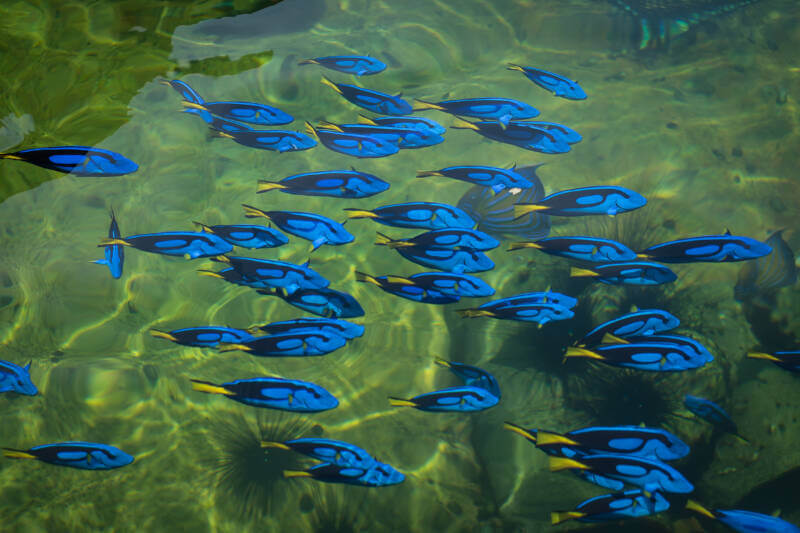
The Acanthuridae family includes all of the surgeonfish. This means the tangs, unicornfish, and doctorfish.
They’re set apart by the presence of “scalpels” on both sides of the tail base. The spines work for both defense and offense, making tangs pretty formidable fish.
You’ll find eighty color options in the tang group. It’s enough to make any aquarist’s head spin!
However, they’re not the easiest group to add to a reef tank. These saltwater fish present plenty of challenges – and that scalpel’s the tip of the iceberg.
Before you rush to your local fish store to place a tang order, do your homework. Some species make better choices for a marine aquarium than others.
And most of them require a fair amount of experience – if you want them to survive. No one said finding “Dory” would be easy.
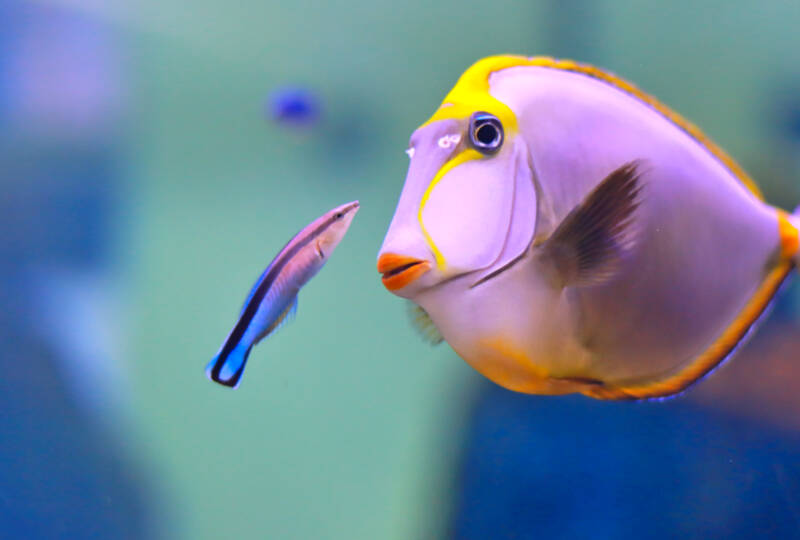
[toc]
Behavior: Tang Aggression
While you’ll find some variation in personality and temperament, tangs have a reputation for bullying.
They simply don’t tolerate the presence of other tangs in their territory. And that goes double (triple?) for members of their own species.
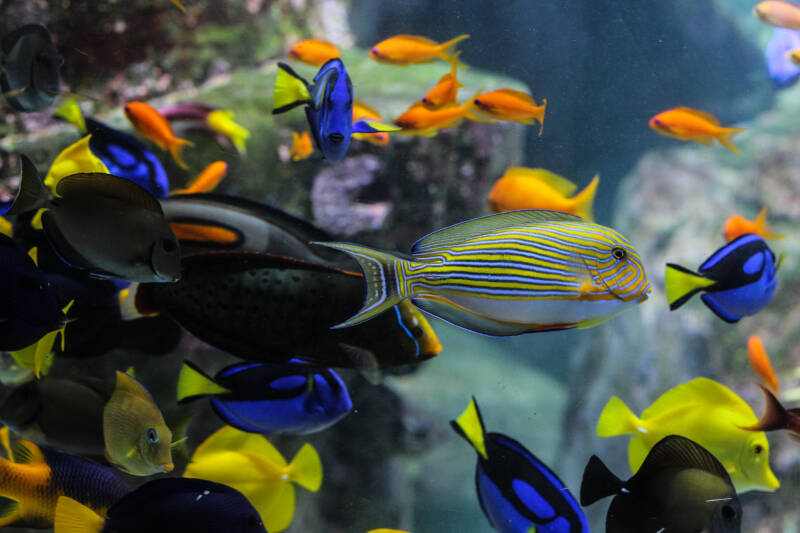
It seems strange, especially when any diver can produce pictures of tang shoals. In the wild, many tangs cruise the reef together without a problem. And not just in pairs, either. You’ll find entire groups within a few fin lengths of each other.
Put those same fish in a marine tank, though, and carnage ensues. They engage in battles with their scalpels.
The losing fish is left to dash for the nearest hiding place. Often, the resulting stress (and an inability to seek out food) leads to an unfortunate death.
And tang aggression doesn’t stop within their family group. If they seem a fish that LOOKS similar, a challenge begins.
You risk starting a squabble when you pair a tang with angelfish or butterflyfish species. And they DON’T have spines to provide defense!
What’s the best way to manage that bullying? Usually, limiting yourself to a single tang.
Aquascaping a reef tank to divide up territories might work, but you’re taking a risk. And since they’re not the healthiest fish in the ocean, playing it safe works best.
Lifespan and diseases
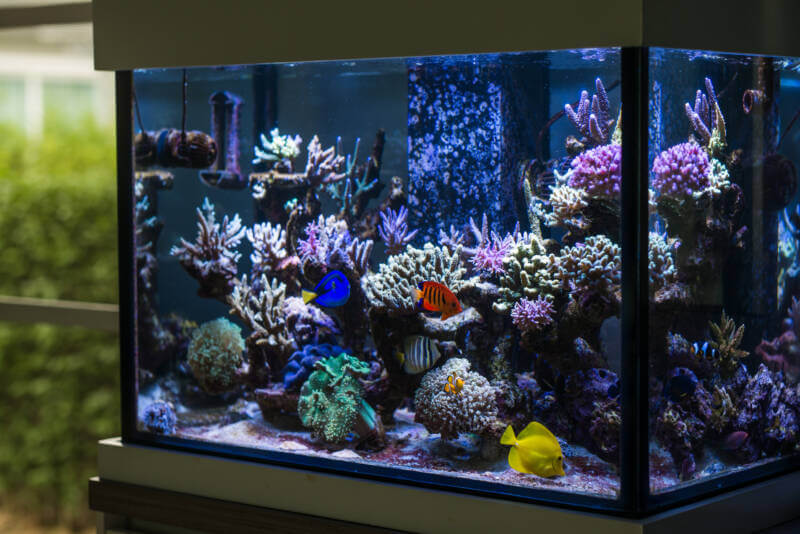
In their natural habitat, some species of tang live as long as 30 years. And if you maximize your quality of care, you may see your fish live up to 25 years. It’s something to strive for.
But the average? It’s more like a few years – when it’s not a few WEEKS. Despite a hardy reputation, many tangs succumb to stress and disease in captivity.
They require a fully-cycled saltwater aquarium with peak water chemistry. If ammonia, nitrates, or nitrites start to wobble, their stress level WILL climb. The result’s usually fatal.
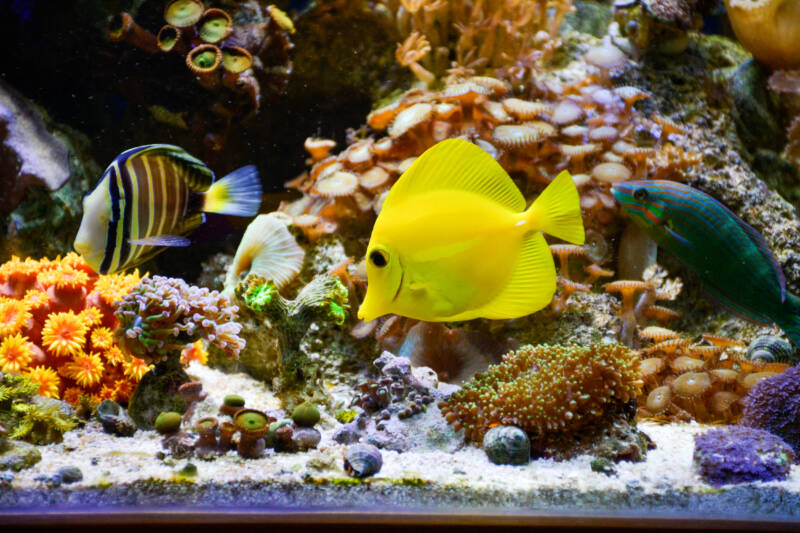
It doesn’t help that the family’s prone to disease, in general. If you want an indicator of infection in your tank, look at your tang. They’ll show the first signs.
Marine ich LOVES tangs. As a matter of fact, you may want to leave a deposit with the fish store – just in case.
All tangs MUST undergo a strict two-week quarantine. If you skip this vital step, you could bring marine velvet or ich into your beautifully healthy reef environment. The delay will also give you time to watch for signs of stress due to collection and transport.
Symbiotic Relationship: Cleaning Stations

Due to their penchant for disease, you should consider mixing tangs and cleaner shrimp.
These handy invertebrates will help remove nasty parasites from your fish. It’s a symbiotic relationship that exists in nature.
Consider the region where your tang species comes from. You can then research the shrimp native to that area (assuming you don’t have crustaceans in the aquarium already).
Then you can sit back and observe the natural cleaning process.
Food and Diet

Tangs are herbivores. They spend their days in a constant grazing process in the ocean, picking microalgae off the reef. This habit makes them a valuable part of the cleaning crew in your tank.
But making sure they get ENOUGH food can get challenging. If you have other algae-eaters competing for resources, you’ll need to supplement your tangs.
It’s not a complicated process. After all, vegetables and vegetable material is easy to come by. There are plenty of spirulina-based commercial foods on the market.
You can also substitute genuine plants into the mix. Nori sheets work beautifully. You can attach them with a vegetable clip every day.
If you want to increase the nutrients, soak them in a blend of supplements. And there are other vegetables you can add:
- Lettuce
- Peas
- Spinach.
You WILL need to add in the occasional protein source to balance things out. It sounds strange to feed mysis and brine shrimp to an herbivore, but it works.
Your vegetables come out short on protein and vitamins. The shrimp make up the difference.
A Balanced Diet
If tangs don’t receive enough food – or the wrong foods – they can develop head and lateral line erosion. The soft-tissue disease results from nutritional deficiencies.
It looks horrifying (of course it does – your fish has a divot in their head!), but it’s easy to correct.
When you balance out your tang’s diet and provide enough sustenance, the fish recovers. This is another reason quarantine is helpful. It allows you to observe your tang’s feeding habits. You’ll make sure they ARE eating and what their preferences are.
Types of Tangs
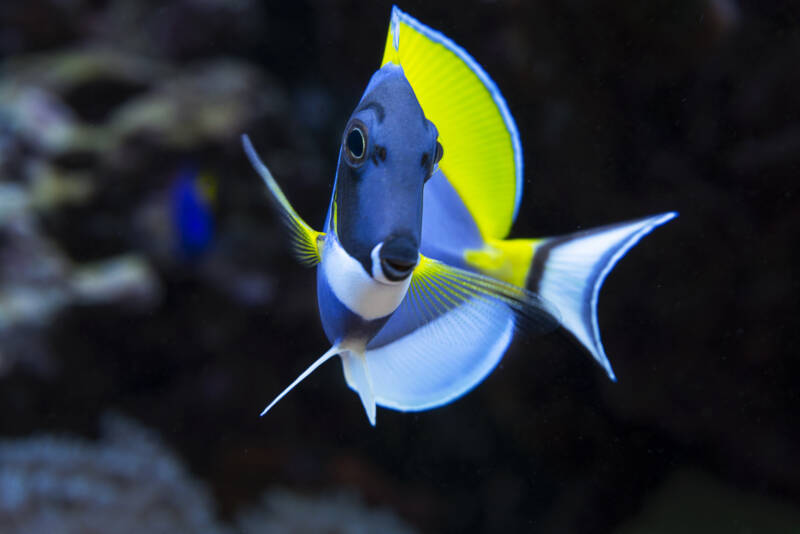
Tangs cover the entire rainbow when it comes to patterns and colors.
They also vary in size. It’s one of the things that makes them so popular for saltwater aquariums. And even if you can only keep one, they’re stunning centerpiece fish for reef tanks.
However, they’re not the most affordable saltwater species. You may need to save your pennies for a few months (or years!) before you bring one home.
That kind of investment encourages you to make sure you have everything running smoothly. And captive-bred WILL come cheaper.
Before you take on a tang, do as much research as possible. “Dory” may be popular with the general public, but that might not be the tang for you.
Perhaps you want something showier. Or maybe you want something grander in size. As long as you know what you’re in for.
1. Achilles Tang (Acanthurus achilles)
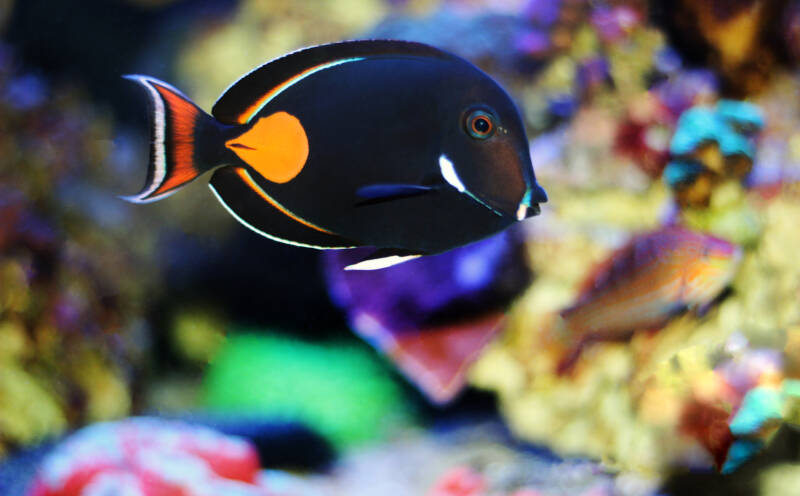
- In the Wild: Pacific
- Length: 10 inches (25 cm)
- Difficulty: Difficult
- Temperament: Aggressive
- Tank Size: 120 gallons (454 l)
- Cost: $400-$600
Achilles tangs look stunning, with nearly-black scales and an orange patch near their tails (the “tang”).
And they certainly have the personality of the Greek hero they’re named after. They’ll take on any other tang of their genera – not to mention plenty of other fish.
Unfortunately, they have an “Achilles heel,” so to speak (despite lacking feet). They’re highly susceptible to EVERY tang illness.
And it doesn’t help that they’re picky about the menu. You may need to grow your microalgae to keep them happy!
And while they have no problem dishing out the aggression, they can’t take it. Triggerfish and the larger members of the angelfish group have no problem fighting back. That leaves the Achilles tang running for cover – and getting stressed. They often die as a result.
2. Black Tang (Zebrasoma rostratum)
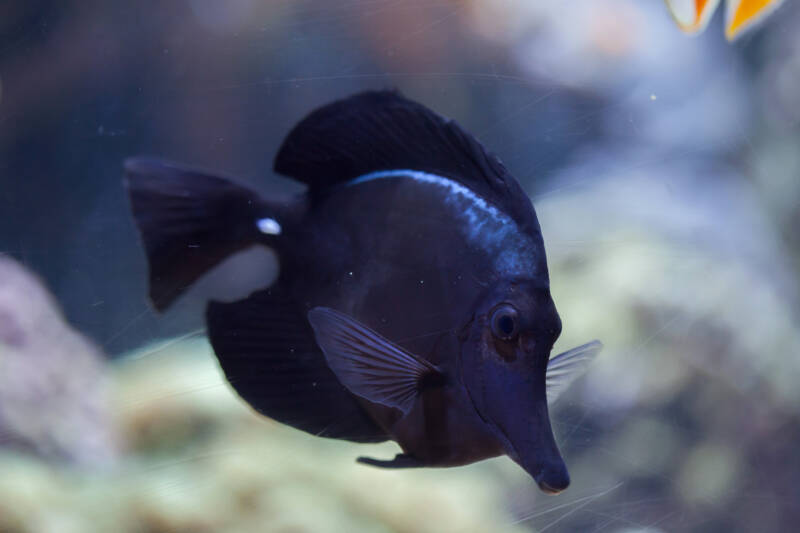
- In the Wild: South Pacific
- Length: 10 inches (25 cm)
- Difficulty: Easy
- Temperament: Aggressive
- Tank Size: 120 gallons (454 l)
- Cost: $600-$1400
Finding any fish with solid black coloring is rare, and black tangs are no exception. They’re challenging to locate, which gets reflected in their pricing.
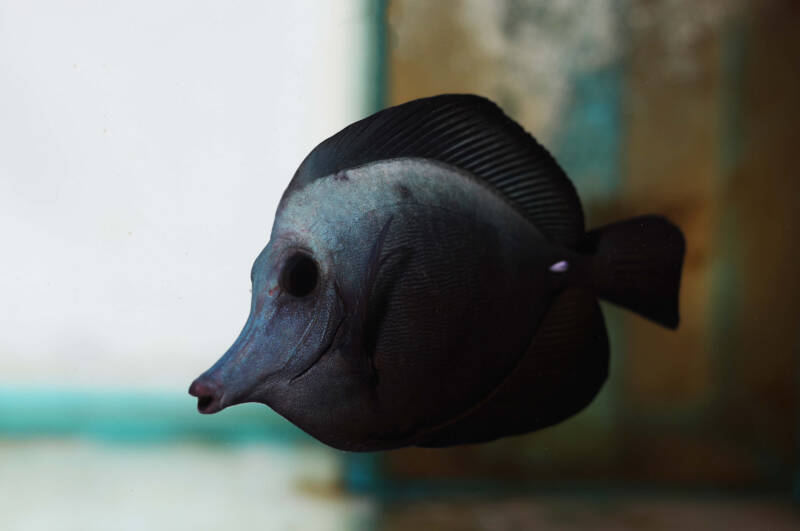
They only hang out around a few of the more remote archipelagos in the southern Pacific. It makes the collection a challenge.
Despite their rarity, they’re not tricky for aquarists to manage. Once you get them into your reef tank, they settle in.
You still need to avoid pairing them with any other tangs, unfortunately. They’d look gorgeous together, but these night-dark surgeonfish are spunky.
Black tangs aren’t picky when it comes to the menu, though. They happily chow down on nori, commercial fish foods, and even shrimp.
It’s a shame they’re so difficult for most aquarists to find to bring home!
3. Royal Blue Tang/Palette surgeonfish (Paracanthurus hepatus)
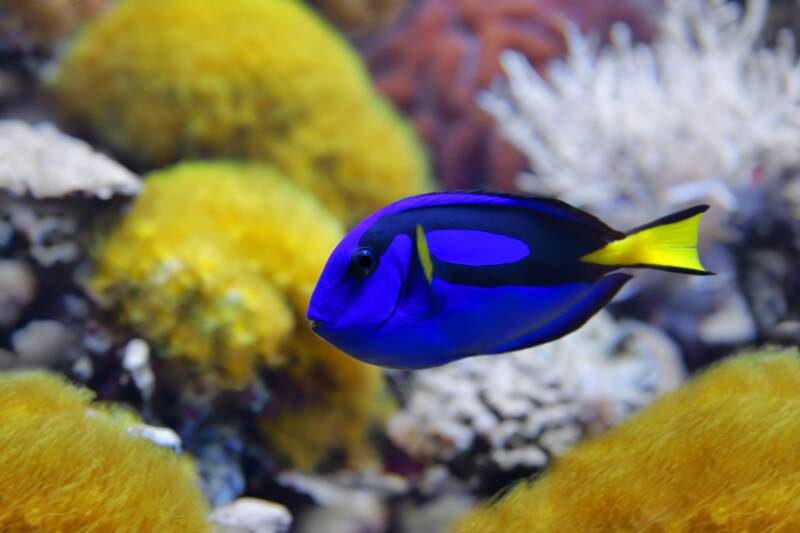
- In the Wild: Indo-Pacific
- Length: 12 inches (30 cm)
- Difficulty: Moderate
- Temperament: Semi-Aggressive
- Tank Size: 180 gallons (681l)
- Cost: $60-$250
“Just keep swimming, just keep swimming.” That’s right; it’s “Dory!” royal blue tangs – or hippo tangs or blue tangs – won everyone’s hearts in the movies. They featured prominently in marine tanks before the films, though. (Sorry, “Dory”)
The soft freckles on the blue and yellow (it’s a popular color choice) make these tangs stand out in a crowd.
If you purchase the shoal all at once and introduce them to the tank together, they’ll get along without a problem! They’re one of the more peaceful tangs out there.

However, royal blues aren’t for the novice aquarist (a problem that cropped up after the movies). They desperately need proper nutrition and a mature aquarium.
Without high water quality, they get stressed and lay on their sides in the tank
4. Brown Tang/Brown Surgeonfish (Acanthurus nigrofuscus)

- In the Wild: South Pacific
- Length: 8,3 inches (21 cm)
- Difficulty: Easy
- Temperament: Semi-Aggressive
- Tank Size: 55 gallons (208 l)
- Cost: $40
You may see brown tangs listed under the common name of lavender tang.
They’re not the most colorful species in the group, but they ARE one of the smallest. It makes them approachable (and affordable) for novice aquarists.
They also dial it down on the famous tang aggression. They’ll still pick fights with one another, but you CAN pair them up with other tangs. (Well, assuming you locate and enjoy a species that tolerates other tangs)
They have one of the most peaceful demeanors in the group.
Despite the small size of brown tangs, you’ll want to go for as much horizontal space as possible with your tank. They’re super-active. If you can, aim for a length of at least six feet (1.8 m) to allow for maximum swimming room.
5. Clown Tang (Acanthurus lineatus)
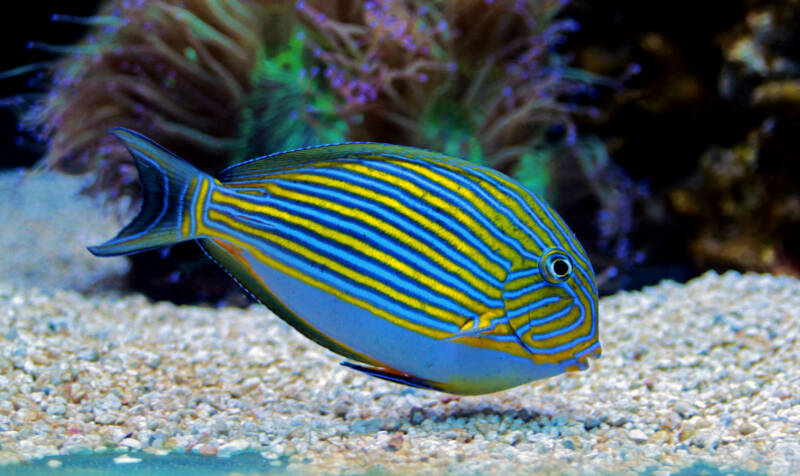
- In the Wild: Indo-Pacific
- Length: Up to 14 inches (35 cm)
- Difficulty: Moderate
- Temperament: Aggressive
- Tank Size: 180 gallons (681 l)
- Cost: $60
Aquarists love the blue and yellow striped pattern of the clown tang. People strive to add them to their reef tanks.
Unfortunately, given their impressive size, it’s not always a possibility. You need AT LEAST 180 gallons (681 l) to house one of these beauties safely.
Don’t try to cut corners, either. Not only do clowns go after other tangs in their bullying runs, but they’ll also target other fish. And since they’re so large, they’re pretty formidable. You’ll need some experience to handle their aggression and territorial needs.
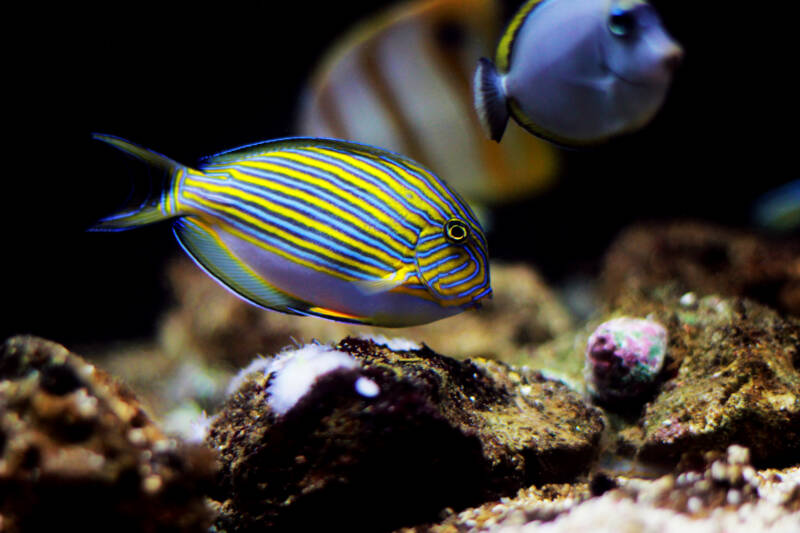
Unhappily, they don’t always survive collection and transportation. They do fine once they get established, but it’s getting to that point that’s tricky.
Ensure you do a thorough inspection when you’re at the fish store, and look for signs of ich.
6. Fowleri Tang (Acanthurus fowleri)
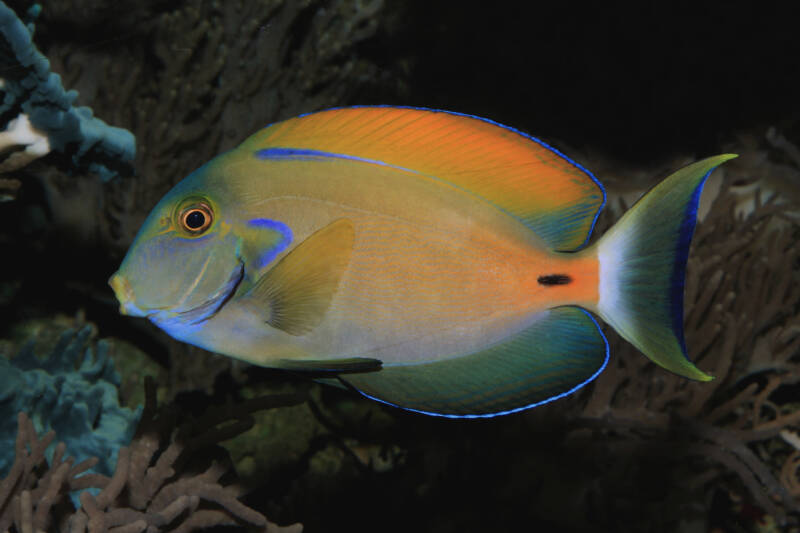
- In the Wild: Indonesia
- Length: 18 inches (45 cm)
- Difficulty: Moderate
- Temperament: Peaceful
- Tank Size: 300 gallons (1135 l)
- Cost: $189-$250
Welcome to one of the largest members of the tang family! The fowleri tang reaches an impressive 18 inches (45 cm) when fully grown. Most of it comes from a flowing tail of yellow and white, streaming out from a gray-brown body with blue and gold accents on the fins.
Fowleri tangs also appear under the names horseshoe surgeonfish and black spine surgeonfish.
They have sweet tempers, making them rare finds in this group of saltwater fish. The long tail gives them a graceful quality you don’t see in other members.
Unfortunately, you need a MASSIVE tank to provide the best swimming room.
They also don’t appear on the stock lists of fish stores very often. It makes them difficult for most aquarists to add to their collection. You may go on a waiting list.
7. Gem Tang (Zebrasoma gemmatum)
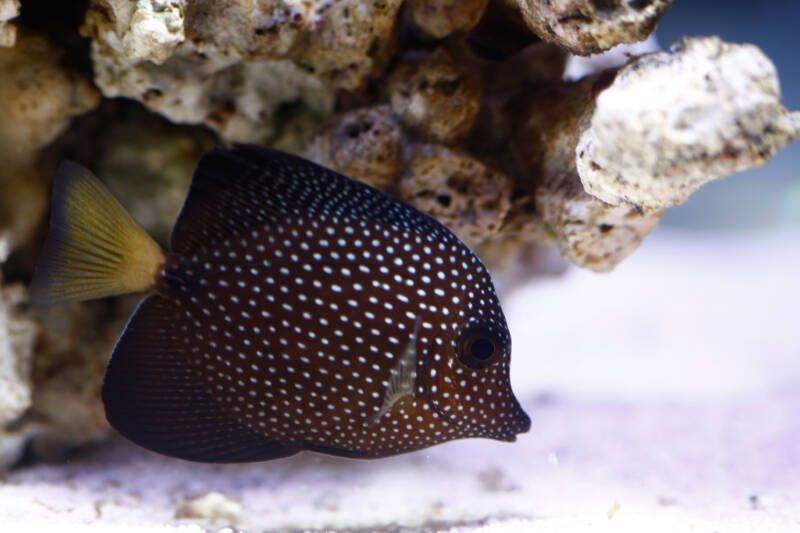
- In the Wild: Western Indian Ocean
- Length: 8.5 inches (21 cm)
- Difficulty: Moderate
- Temperament: Semi-Aggressive
- Tank Size: 120 gallons (454 l)
- Cost: $1,500-$2,000
If you hope to bring a gem tang into your marine tank, consider opening a savings account. These are the most expensive tangs in the world.
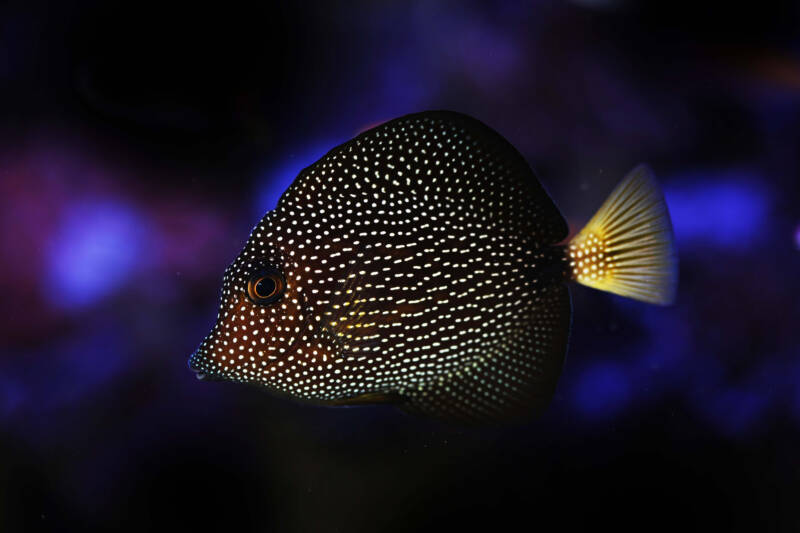
Finding one in the first place is difficult. And when you do? They fetch prices in the THOUSANDS!
Gem tangs are also known as spotted tangs, which makes a little more sense. They have dozens of white spots covering their bodies. The result is a beautiful fish – a “gem” of the reef, if you will. (And, at that price, the name definitely counts!)
They don’t tolerate one another any better than other tang species, which is probably a good thing. (Can you imagine BUYING more than one?!)
They have a hardy nature that does well in the captive environment for all of their rarity and cost.
8. Kole Tang (Ctenochaetus strigosus)

- In the Wild: Indo-Pacific
- Length: 6 inches (15 cm)
- Difficulty: Easy
- Temperament: Semi-Aggressive
- Tank Size: 70 gallons (265 l)
- Cost: $70-$110
Kole tangs are another tang that adopts the spotted look. Luckily, they aren’t as expensive as gem tangs.
However, early Polynesians treated them a delicacy. They were considered a “royal food.” Anyone else caught eating one ended up executed. (So, still impressive!)
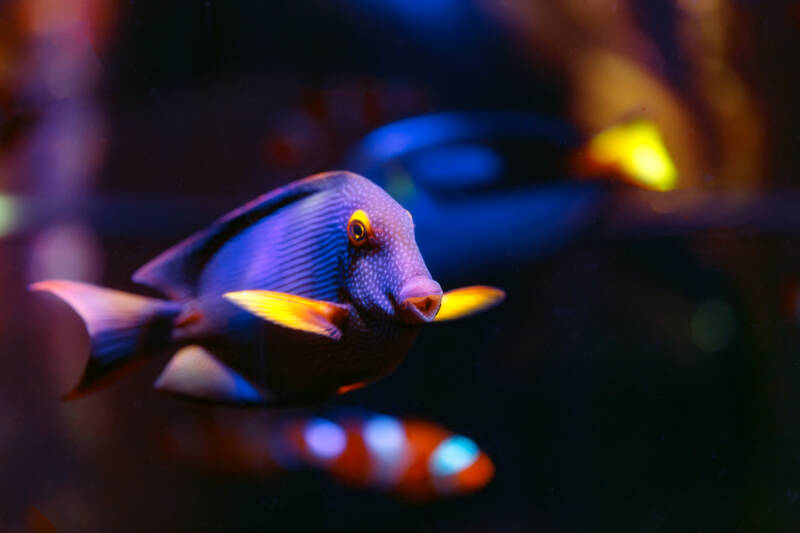
You’ll often see kole or yellow-eyed tangs cleaning algae on sea turtle shells around Hawaii. The islands form a vital migration stop, and the koles create cleaning stations for the reptiles. The tangs get a meal, and the turtles shed the drag the clinging algae produces.
While koles CAN get aggressive with each other, aquarists have successfully kept them in shoals.
They’re on the smaller side with more peaceful demeanors. If you want to take the risk, up your marine tank size as much as possible.
9. Lemon Tang/Mimic Lemon Peel Tang (Acanthurus pyroferus)
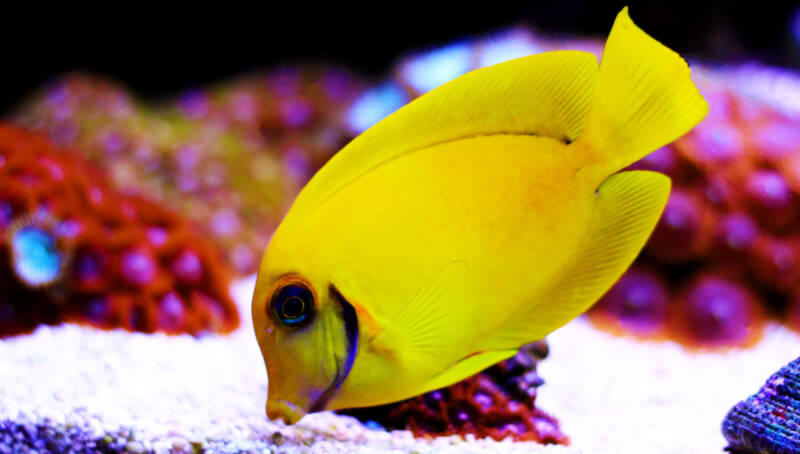
- In the Wild: Indonesia, Fiji
- Length: 10 inches (25 cm)
- Difficulty: Easy
- Temperament: Semi-Aggressive
- Tank Size: 150 gallons (567 l)
- Cost: $50-$170
A couple of tang species wear the yellow shade at some point in their life.
Lemon tangs, however, stay a brilliant yellow color from juvenile to adult. It’s one of the most attractive things about them that draws aquarists in.
They also tolerate other tang species. So while you won’t get a shoal of lemons swimming throughout your tank, you CAN consider mixing them with a different color palette to get a colorful display.
Lemon tangs are active swimmers. As such, you want to provide as much open swimming space as possible.
This means allowing for the necessary live rock they need for grazing, caves, and swimming room. If you have room for a bigger tank, go for it.
10. Naso Tang/Lipstick Tang (Naso lituratus)
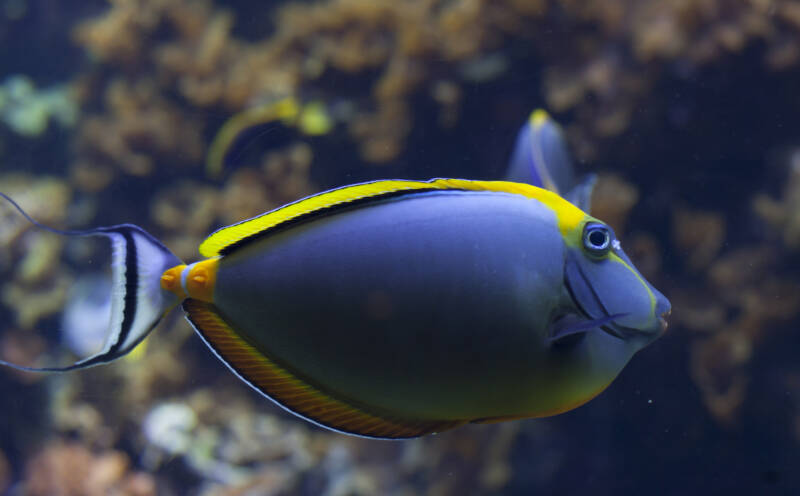
- In the Wild: Pacific
- Length: 18 inches (45 cm)
- Difficulty: Easy
- Temperament: Peaceful
- Tank Size: 300 gallons (1135 l)
- Cost: $150-$360
If you want to see the largest tang species, look no further than the naso tang. Some members reach a staggering length of 2 feet (61cm)!
It means you’re going to need to splurge on an enormous tank to provide enough swimming room – but they’re worth it.
Naso tangs break the mold with a peaceful temperament. They’re comfortable in groups – with each other AND other species!
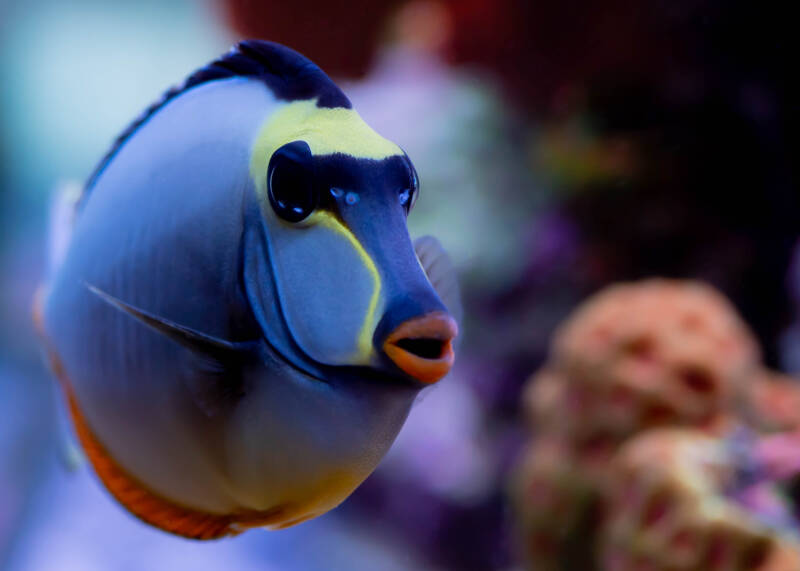
Of course, you’re going to need OVER 300 gallons (1135 l), which isn’t practical for most aquarists. So you may need to stick to one.
These colorful tangs – named for the red outline of their mouths – actually vary in color.
Depending on where they’re collected, you can see a different shade to the scales. They also CHANGE color depending on their mood!
11. Powderblue Tang (Acanthurus leucosternon)
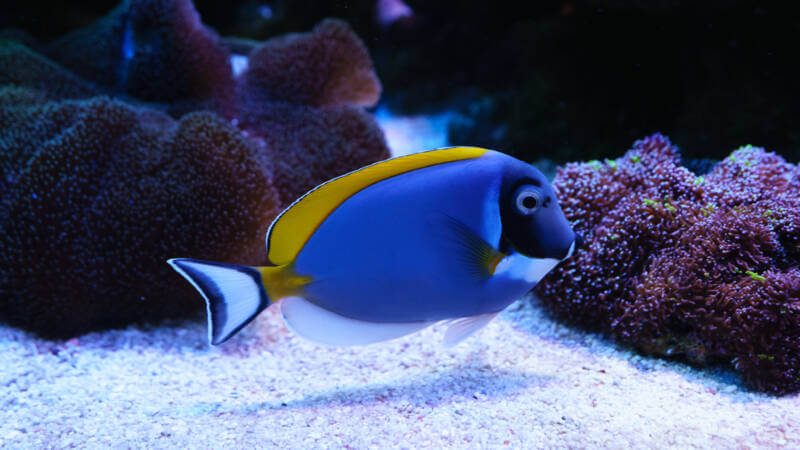
- In the Wild: Indian Ocean
- Length: 9 inches (23 cm)
- Difficulty: Difficult
- Temperament: Semi-Aggressive
- Tank Size: 90 gallons (340 l)
- Cost: $140-$200
Blue’s a popular color in the tang family. And while powder blue tangs combine the blue and yellow shades into a stunning palette, they’re not quite as popular as other species.
It’s a shame because they stand out in a colorful reef tank with those black superhero masks.
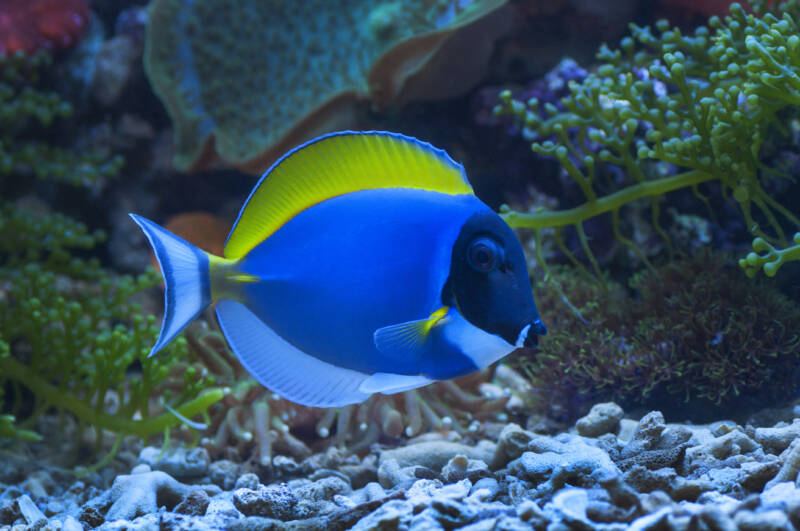
Most of the reluctance to powder blues comes from their delicate constitutions. They’re SUPER sensitive.
The fish rarely survive collection and transport in the first place. Then they go on hunger strikes. By the time they reach an aquarium, they’re usually sick and fading fast.
If you find a healthy powder blue tang, you can consider setting them up in a shoal.
You’ll need to make sure there’s plenty of algae available, though. If food resources dip too low, fights will break out, and then you’ll face stress issues.
12. Purple Tang (Zebrasoma xanthurum)
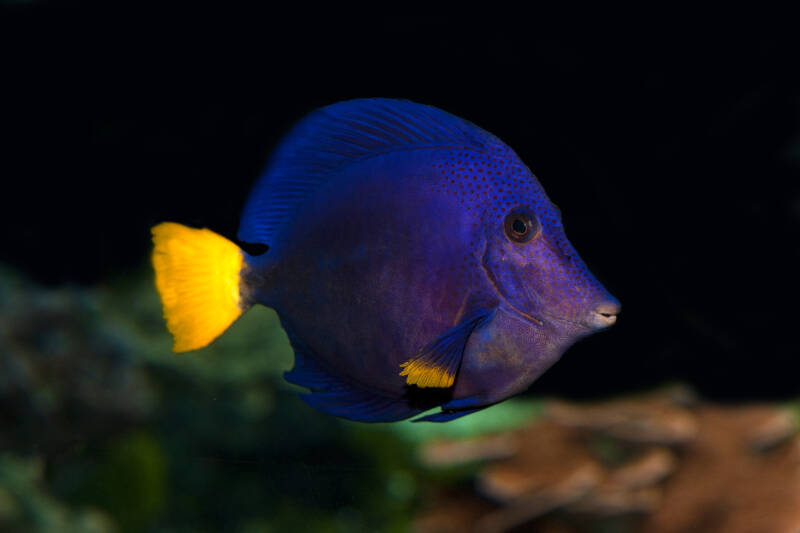
- In the Wild: Indian Ocean
- Length: 9 inches (23 cm)
- Difficulty: Moderate
- Temperament: Semi-Aggressive
- Tank Size: 100 gallons (378 l)
- Cost: $300-$500
“Purple” is a bit of a misnomer. Purple tangs are another species to carry the blue and yellow color scheme. Black flecks along their bodies deepen the blue shading toward indigo, giving them a unique appearance.
You find purple tangs in the Red Sea, with a few smaller populations here and there in the Indian Ocean.
They’re a little pricier due to the difficulty in their collection, so make sure you set some funds aside.
Divers and snorkelers often spot purple tangs hanging out in pairs and shoals. It’s a beautiful sight, but not one that extends to the reef tank. The confined space starts up that famous tang aggression, and they WILL turn on each other.
13. Sailfin Tang (Zebrasoma veliferum)
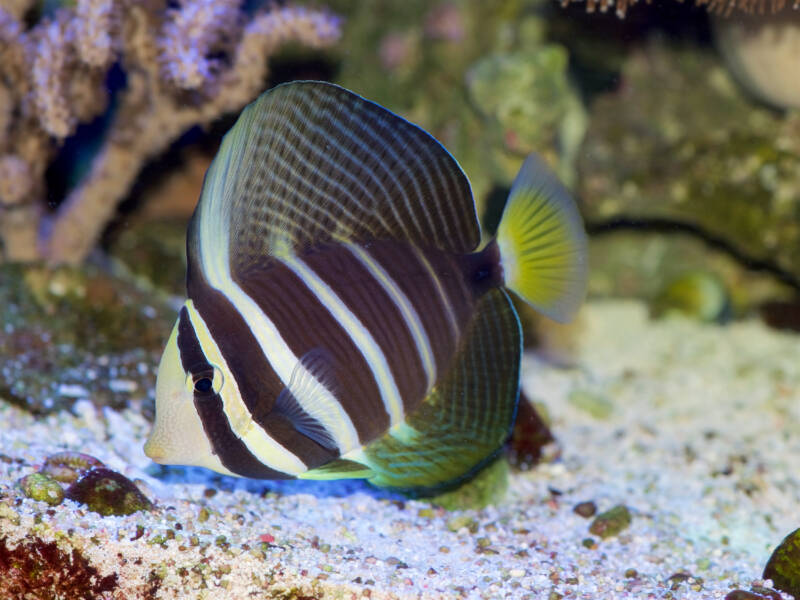
- In the Wild: Indo-Pacific
- Length: Up to 15 inches (38 cm)
- Difficulty: Easy-Moderate
- Temperament: Semi-Aggressive
- Tank Size: 150 gallons (568 l)
- Cost: $60-$150
If you want to go for maximum fin dimensions, look no further than the sailfin tang.
With a dorsal fin that expands into a “sail,” they often outgrow the tanks they settled into as juveniles. It’s a trap the unwary fall into time and time again.
Sailfin tangs are the largest in the Zebrasoma genus. They use that sail and their long anal fin to stretch out and look more intimidating when confronted by a potential predator.
That isn’t to say they’re not aggressive themselves – they are. They don’t like tangs (as you might guess).
People occasionally mistake the sailfin for the Desjardin’s sailfin tang.
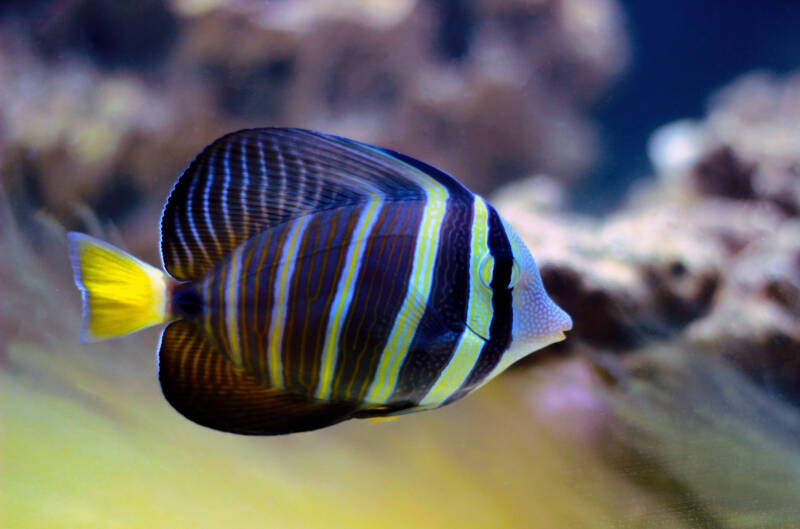
Both have vertical striping along their bodies, but they live in different regions. Desjardin’s sailfins call the Red Sea home. Also, they have white freckles covering the front of their bodies.
14. Scopas Tang (Zebrasoma scopas)
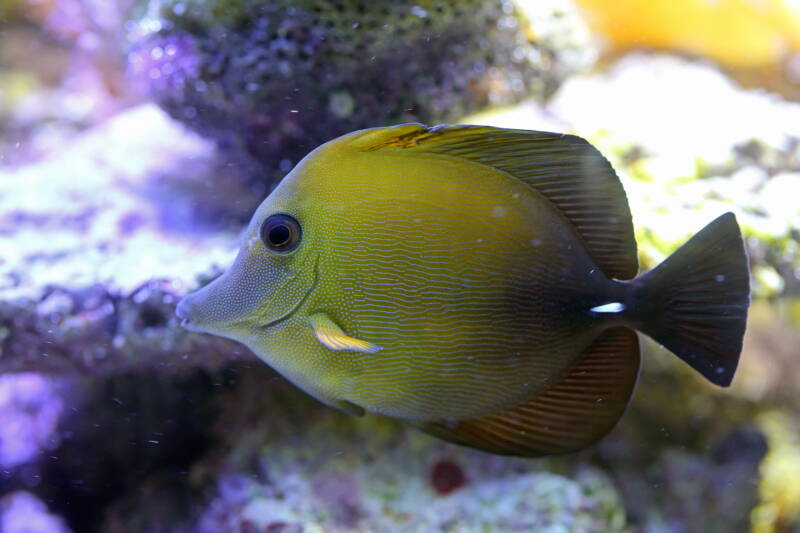
- In the Wild: Indo-Pacific
- Length: 12 inches (30 cm)
- Difficulty: Easy-Moderate
- Temperament: Aggressive
- Tank Size: 125 gallons (473 l)
- Cost: $40-$110
Scopas tangs make great additions to reef tanks. They come in different colors and patterns – something that causes them to get confused with the juveniles of other Zebrasoma tangs.
You’ll see everything from gray to yellow. It’s even possible to see black (creating MORE confusion).
They’re on the larger end of the tang spectrum. And since they have an aggressive streak that goes straight to the bone, you want to go the “bigger is better” route to aquarium size. As impressive as the scopas are in appearance, stick to just one.
They are hardy, though. They’re not as likely to develop head and lateral line erosion as other tang species.
You still need to stay on top of your water quality (of course), but that gives you some peace of mind.
15. Sohal Tang (Acanthurus sohal)
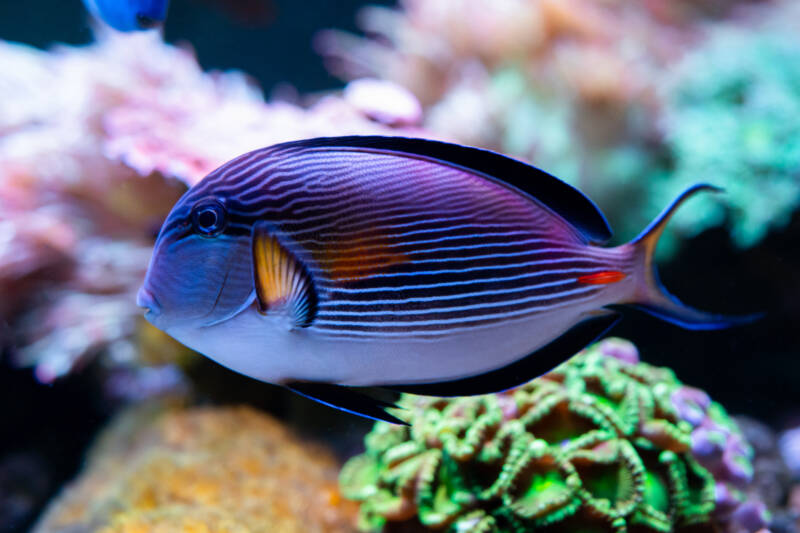
- In the Wild: Indian Ocean
- Length: 16 inches (40 cm)
- Difficulty: Easy-Moderate
- Temperament: Aggressive
- Tank Size: 100 gallons (378 l)
- Cost: $100
Sohal tangs have a brilliant blue outline that helps them stand out in any setting.
Their white scales slowly incorporate bluish-black stripes, with occasional orange accents. Most prominent is the orange slash at their tail base – right over the spines.
You may find sohal tangs listed as Red Sea clown surgeons. They appear throughout the Arabian Sea, Persian Gulf, and (you guessed it) the Red Sea.
Unlike most tang species, people collect them via nets. It’s a gentler process that allows for a healthier catch and shipment.
Unhappily, these gorgeous saltwater fish are extremely aggressive. You shouldn’t attempt to sneak any other tangs into the tank.
And, unfortunately, you can’t pair them with wrasses, either. They’ll hunt down the other fish for a sparring match.
16. Tomini Tang (Ctenochaetus tominiensis)
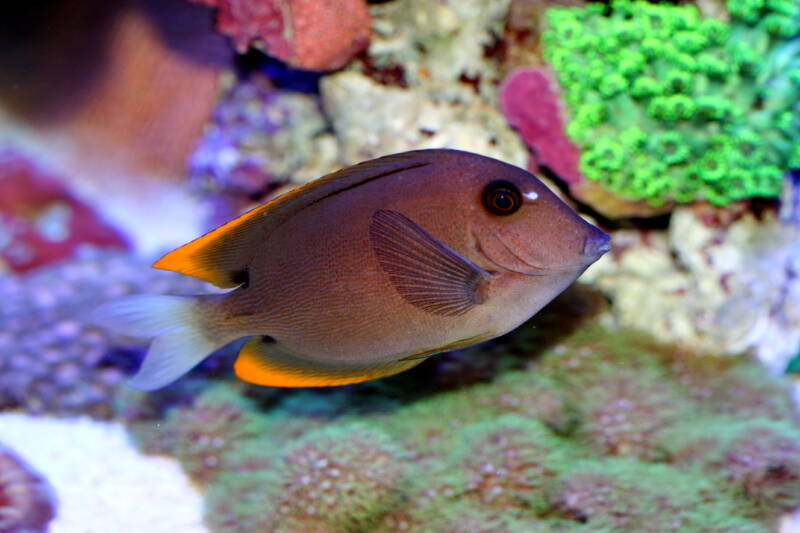
- In the Wild: Indo-Pacific
- Length: 6 inches (15 cm)
- Difficulty: Easy-Moderate
- Temperament: Semi-Aggressive
- Tank Size: 55 gallons (208 l)
- Cost: $90-$600
Tomini tangs hang out at the short end of the tang spectrum. They’re brown with yellow accents on the fins. It’s unassuming, but they’ll still look attractive in a marine aquarium.
And since they won’t grow to horrific proportions, they’re popular with aquarists.
Tominis make great additions to your clean-up crew. They, of course, clear out the algae. But they also eat any waste hanging out. (It’s a disgusting job, but someone has to do it)
You’ll still need to make sure you balance their diet to keep them healthy, though.
They aren’t the most aggressive tangs out there, but they WILL bully any fish you add to the tank after them. The harassment SHOULD slow down, eventually. Really, though, tangs do best when they’re the final addition to the tank.
17. Vlamingi Tang (Naso vlamingii)

- In the Wild: Indo-Pacific
- Length: 23.6 inches (60 cm)
- Difficulty: Easy
- Temperament: Aggressive
- Tank Size: 300 gallons (1135 l)
- Cost: $35
The vlamingi tang is also known as the bignose unicornfish, and it’s a stunning member of the group.
They change colors! On a reef, you’ll see a slate blue when the tang’s swimming and a paler blue as it glides into a cleaning station. During courtship, males develop bright patterns.
Vlamingi tangs come just shy of the leaderboard when it comes to size.
You’ll still want to maximize tank space, though, especially because they’re one of the most aggressive tangs out there. If you don’t give them room to move, you’ll see problems.
Unfortunately, they’re one of the few tang species that DON’T qualify as reef-safe fish. They’re clumsy!
They swim so fast, and they don’t look where they’re going. As such, they often knock over LPS (large polyp stony) corals. You’ll want to keep them in fish-only tanks.
18. Yellow Tang (Zebrasoma flavescens)
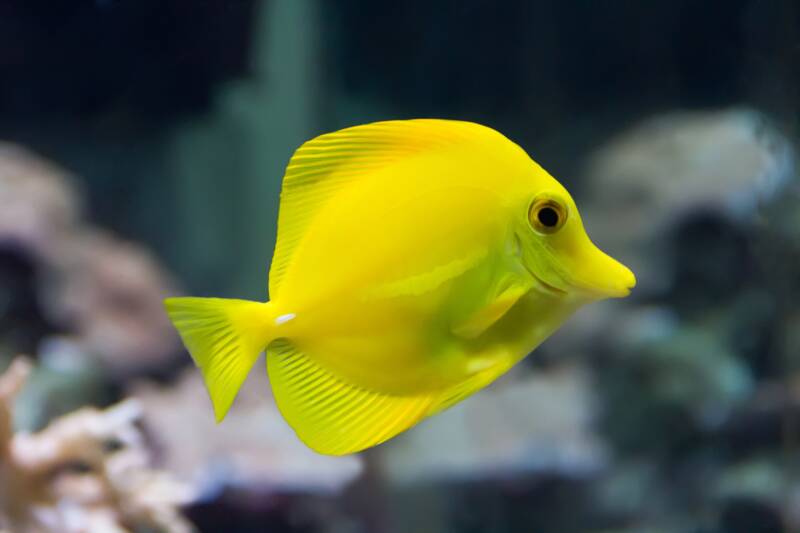
- In the Wild: Pacific
- Length: Up to 8 inches (20.3cm)
- Difficulty: Easy
- Temperament: Semi-Aggressive
- Tank Size: 55 gallons (208L)
- Cost: $70-$500
Yellow tangs hold the honor of the most popular species of the bunch.
They’re lucky: the western coast of Hawaii is full of nutrient-rich waters PERFECT for captive-breeding programs. As such, it’s no problem to get the Yellow Tang out to pet stores.
They’re also another of the tangs that do fine in schools. You need to start them as young as possible, and everyone needs to go into your reef tank AT THE SAME TIME.
If you do that, you won’t see any aggression problems. If you don’t, expect bullying.
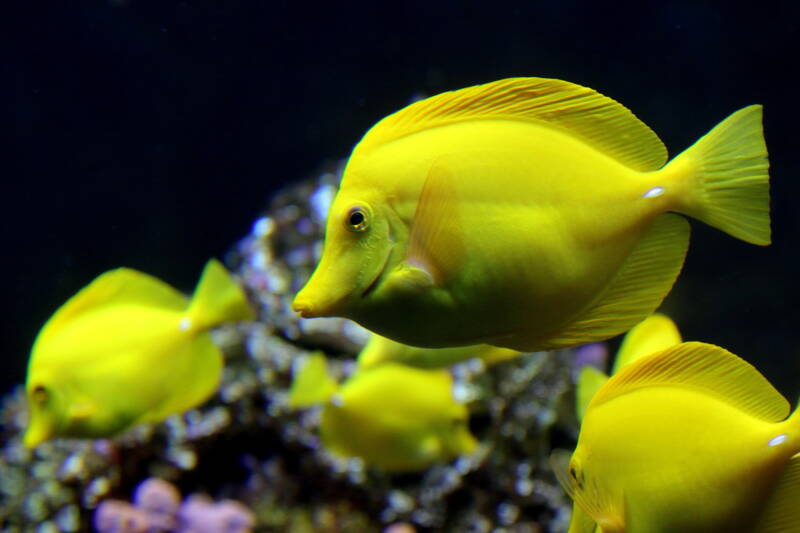
Captive-bred yellow tangs do well. They don’t develop marine ich or HLLE disease as frequently as their wild cousins.
You still need to do your part, though. But it’s an argument for looking at the label in the pet store closely.
“Dory” and Her Cousins
Tangs have made appearances in saltwater aquariums for decades – well before the Pixar movies introduced the public to “Dory.” But that popularity helped keep them in the public eye, which isn’t a bad thing!
Unhappily, if people aren’t aware of the tricks that come with keeping tangs, they find themselves with problems.
Novices set up schools and end up confronted with aggression. Or they don’t feed properly and lose their fish within a few weeks.
The tangs include an array of colors and patterns. They’re active swimmers, and they participate in clean-up.
But you need to understand what you’re getting yourself into, which means some careful homework before bringing one of these beauties home.
Which species of tang is your favorite? Have you ever witnessed a tang duel?
What’s your preferred method for keeping the algae levels up?
Share your stories and questions with us here!
